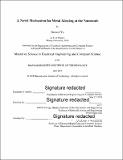| dc.contributor.advisor | Ju Li. | en_US |
| dc.contributor.author | Yu, Daiwei | en_US |
| dc.contributor.other | Massachusetts Institute of Technology. Department of Electrical Engineering and Computer Science. | en_US |
| dc.date.accessioned | 2018-09-17T15:54:36Z | |
| dc.date.available | 2018-09-17T15:54:36Z | |
| dc.date.copyright | 2018 | en_US |
| dc.date.issued | 2018 | en_US |
| dc.identifier.uri | http://hdl.handle.net/1721.1/118032 | |
| dc.description | Thesis: S.M., Massachusetts Institute of Technology, Department of Electrical Engineering and Computer Science, 2018. | en_US |
| dc.description | Cataloged from PDF version of thesis. | en_US |
| dc.description | Includes bibliographical references (pages 39-40). | en_US |
| dc.description.abstract | The controllable incorporation of multiple immiscible elements into a single nanoparticle merits untold scientific and technological potential, yet remains a challenge using conventional synthetic techniques. We propose a novel mechanism for metal alloying at the nanoscale, which provides a general route for alloying dissimilar elements into single-phase solid-solution nanoparticles, referred to as high-entropy-alloy nanoparticles (HEA-NPs). To validate the theory, we developed a facile carbothermal shock (CTS) method to synthesize a wide range of multicomponent (up to eight dissimilar elements) nanoparticles with a desired chemistry (composition), size, and phase (solid solution, phase-separated) by controlling the CTS parameters (substrate, temperature, shock duration, and heating/cooling rate). To prove utility, we synthesized quinary HEA-NPs as ammonia oxidation catalysts with -100% conversion and >99% nitrogen oxide selectivity over prolonged operations. This mechanism is distinct from previously reported alloying processes, which can bring about a new repertoire of alloys and nanostructures with unprecedented functionalities. | en_US |
| dc.description.statementofresponsibility | by Daiwei Yu. | en_US |
| dc.format.extent | 40 pages | en_US |
| dc.language.iso | eng | en_US |
| dc.publisher | Massachusetts Institute of Technology | en_US |
| dc.rights | MIT theses are protected by copyright. They may be viewed, downloaded, or printed from this source but further reproduction or distribution in any format is prohibited without written permission. | en_US |
| dc.rights.uri | http://dspace.mit.edu/handle/1721.1/7582 | en_US |
| dc.subject | Electrical Engineering and Computer Science. | en_US |
| dc.title | A novel mechanism for metal alloying at the nanoscale | en_US |
| dc.type | Thesis | en_US |
| dc.description.degree | S.M. | en_US |
| dc.contributor.department | Massachusetts Institute of Technology. Department of Electrical Engineering and Computer Science | |
| dc.identifier.oclc | 1051458861 | en_US |
